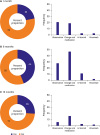1. Lee SE, Cho HJ, Lee HY, et al. A multicentre cohort study of acute heart failure syndromes in Korea: rationale, design, and interim observations of the Korean Acute Heart Failure (KorAHF) registry. Eur J Heart Fail. 2014; 16:700–708.
2. Choi DJ, Han S, Jeon ES, et al. Characteristics, outcomes and predictors of long-term mortality for patients hospitalized for acute heart failure: a report from the Korean heart failure registry. Korean Circ J. 2011; 41:363–371.
3. Lund LH, Edwards LB, Dipchand AI, et al. The Registry of the International Society for Heart and Lung Transplantation: Thirty-third Adult Heart Transplantation Report-2016; focus theme: primary diagnostic indications for transplant. J Heart Lung Transplant. 2016; 35:1158–1169.
4. Ponikowski P, Voors AA, Anker SD, et al. 2016 ESC Guidelines for the diagnosis and treatment of acute and chronic heart failure: the task force for the diagnosis and treatment of acute and chronic heart failure of the European Society of Cardiology (ESC) developed with the special contribution of the Heart Failure Association (HFA) of the ESC. Eur Heart J. 2016; 37:2129–2200.
5. Jung SH, Kim JJ, Choo SJ, Yun TJ, Chung CH, Lee JW. Long-term mortality in adult orthotopic heart transplant recipients. J Korean Med Sci. 2011; 26:599–603.
6. Cha MJ, Lee HY, Cho HJ, Hwang HY, Kim KB, Oh BH. Under-utilization of donor hearts in the initial era of the heart transplant program in Korea- review of 13 years’ experience from the Korea national registry. Circ J. 2013; 77:2056–2063.
7. Ahn C, Koo TY, Jeong JC, et al. Initial report of the Korean Organ Transplant Registry: the first report of national kidney transplantation data. Transplant Proc. 2014; 46:425–430.
8. Mehra MR, Crespo-Leiro MG, Dipchand A, et al. International Society for Heart and Lung Transplantation working formulation of a standardized nomenclature for cardiac allograft vasculopathy-2010. J Heart Lung Transplant. 2010; 29:717–727.
9. Youn JC, Seo SM, Lee HS, et al. Trends in hospitalized acute myocardial infarction patients with heart failure in Korea at 1998 and 2008. J Korean Med Sci. 2014; 29:544–549.
10. Yeom SY, Hwang HY, Oh SJ, Cho HJ, Lee HY, Kim KB. Heart transplantation in the elderly patients: midterm results. Korean J Thorac Cardiovasc Surg. 2013; 46:111–116.
11. Lim JH, Hwang HY, Yeom SY, Cho HJ, Lee HY, Kim KB. Percutaneous extracorporeal membrane oxygenation for graft dysfunction after heart transplantation. Korean J Thorac Cardiovasc Surg. 2014; 47:100–105.
12. Shin HS, Cho HJ, Jeon ES, et al. The impact of hepatitis B on heart transplantation: 19 years of national experience in Korea. Ann Transplant. 2014; 19:182–187.
13. Lee JM, Lee SA, Cho HJ, et al. Impact of perioperative renal dysfunction in heart transplantation: combined heart and kidney transplantation could help to reduce postoperative mortality. Ann Transplant. 2013; 18:533–549.
14. Lund LH, Edwards LB, Kucheryavaya AY, et al. The Registry of the International Society for Heart and Lung Transplantation: Thirty-first Official Adult Heart Transplant Report--2014; focus theme: retransplantation. J Heart Lung Transplant. 2014; 33:996–1008.
15. Lund LH, Edwards LB, Kucheryavaya AY, et al. The Registry of the International Society for Heart and Lung Transplantation: Thirtieth Official Adult Heart Transplant Report--2013; focus theme: age. J Heart Lung Transplant. 2013; 32:951–964.
16. Stehlik J, Edwards LB, Kucheryavaya AY, et al. The Registry of the International Society for Heart and Lung Transplantation: 29th Official Adult Heart Transplant Report--2012. J Heart Lung Transplant. 2012; 31:1052–1064.
17. Lim JY, Jung SH, Kim MS, et al. Cardiac allograft vasculopathy after heart transplantation: is it really ominous? Clin Transplant. 2017; 31:e12883.
18. Eisen HJ, Tuzcu EM, Dorent R, et al. Everolimus for the prevention of allograft rejection and vasculopathy in cardiac-transplant recipients. N Engl J Med. 2003; 349:847–858.






 PDF
PDF ePub
ePub Citation
Citation Print
Print






 XML Download
XML Download